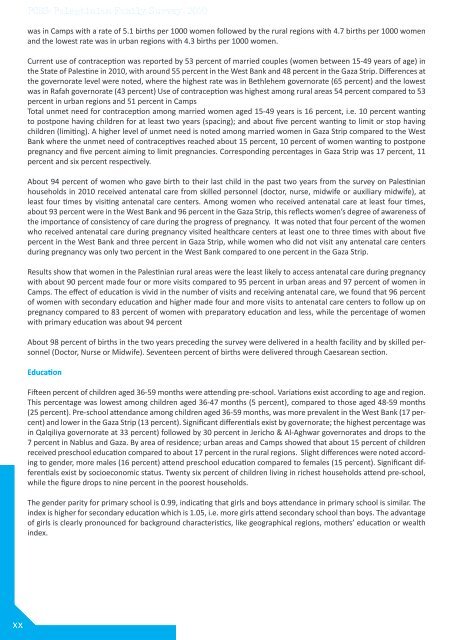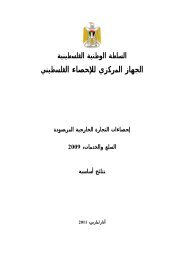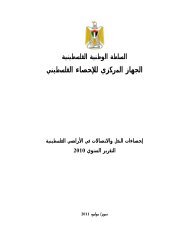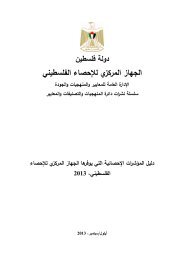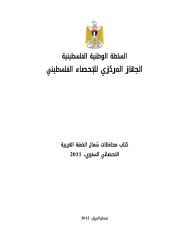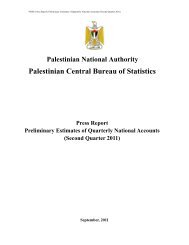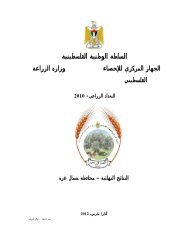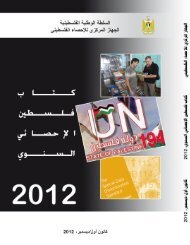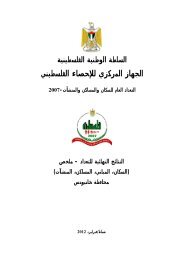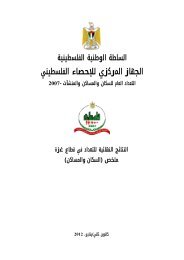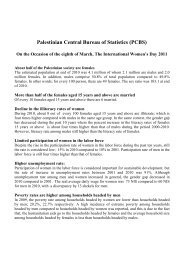Palestinian Family Survey 2010 Final Report - Palestinian Central ...
Palestinian Family Survey 2010 Final Report - Palestinian Central ...
Palestinian Family Survey 2010 Final Report - Palestinian Central ...
- No tags were found...
You also want an ePaper? Increase the reach of your titles
YUMPU automatically turns print PDFs into web optimized ePapers that Google loves.
PCBS: <strong>Palestinian</strong> <strong>Family</strong> <strong>Survey</strong>, <strong>2010</strong>was in Camps with a rate of 5.1 births per 1000 women followed by the rural regions with 4.7 births per 1000 womenand the lowest rate was in urban regions with 4.3 births per 1000 women.Current use of contraception was reported by 53 percent of married couples (women between 15-49 years of age) inthe State of Palestine in <strong>2010</strong>, with around 55 percent in the West Bank and 48 percent in the Gaza Strip. Differences atthe governorate level were noted, where the highest rate was in Bethlehem governorate (65 percent) and the lowestwas in Rafah governorate (43 percent) Use of contraception was highest among rural areas 54 percent compared to 53percent in urban regions and 51 percent in CampsTotal unmet need for contraception among married women aged 15-49 years is 16 percent, i.e. 10 percent wantingto postpone having children for at least two years (spacing); and about five percent wanting to limit or stop havingchildren (limiting). A higher level of unmet need is noted among married women in Gaza Strip compared to the WestBank where the unmet need of contraceptives reached about 15 percent, 10 percent of women wanting to postponepregnancy and five percent aiming to limit pregnancies. Corresponding percentages in Gaza Strip was 17 percent, 11percent and six percent respectively.About 94 percent of women who gave birth to their last child in the past two years from the survey on <strong>Palestinian</strong>households in <strong>2010</strong> received antenatal care from skilled personnel (doctor, nurse, midwife or auxiliary midwife), atleast four times by visiting antenatal care centers. Among women who received antenatal care at least four times,about 93 percent were in the West Bank and 96 percent in the Gaza Strip, this reflects women’s degree of awareness ofthe importance of consistency of care during the progress of pregnancy. It was noted that four percent of the womenwho received antenatal care during pregnancy visited healthcare centers at least one to three times with about fivepercent in the West Bank and three percent in Gaza Strip, while women who did not visit any antenatal care centersduring pregnancy was only two percent in the West Bank compared to one percent in the Gaza Strip.Results show that women in the <strong>Palestinian</strong> rural areas were the least likely to access antenatal care during pregnancywith about 90 percent made four or more visits compared to 95 percent in urban areas and 97 percent of women inCamps. The effect of education is vivid in the number of visits and receiving antenatal care, we found that 96 percentof women with secondary education and higher made four and more visits to antenatal care centers to follow up onpregnancy compared to 83 percent of women with preparatory education and less, while the percentage of womenwith primary education was about 94 percentAbout 98 percent of births in the two years preceding the survey were delivered in a health facility and by skilled personnel(Doctor, Nurse or Midwife). Seventeen percent of births were delivered through Caesarean section.EducationFifteen percent of children aged 36-59 months were attending pre-school. Variations exist according to age and region.This percentage was lowest among children aged 36-47 months (5 percent), compared to those aged 48-59 months(25 percent). Pre-school attendance among children aged 36-59 months, was more prevalent in the West Bank (17 percent)and lower in the Gaza Strip (13 percent). Significant differentials exist by governorate; the highest percentage wasin Qalqiliya governorate at 33 percent) followed by 30 percent in Jericho & Al-Aghwar governorates and drops to the7 percent in Nablus and Gaza. By area of residence; urban areas and Camps showed that about 15 percent of childrenreceived preschool education compared to about 17 percent in the rural regions. Slight differences were noted accordingto gender, more males (16 percent) attend preschool education compared to females (15 percent). Significant differentialsexist by socioeconomic status. Twenty six percent of children living in richest households attend pre-school,while the figure drops to nine percent in the poorest households.The gender parity for primary school is 0.99, indicating that girls and boys attendance in primary school is similar. Theindex is higher for secondary education which is 1.05, i.e. more girls attend secondary school than boys. The advantageof girls is clearly pronounced for background characteristics, like geographical regions, mothers’ education or wealthindex.xx


